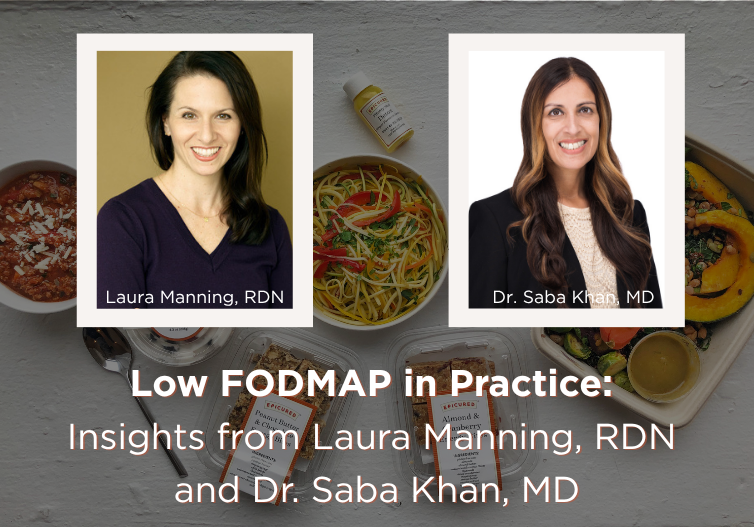I was fortunate to sit down with Laura Manning, Clinical Nutrition Manager at Mount Sinai and nationally recognized expert in gastrointestinal nutrition, for her take on the Low FODMAP diet—its utility, patient selection, and practical implementation. This conversation is especially useful for providers supporting patients with GI disorders.
Dr. Saba Khan:
Laura, thank you so much for joining me and sharing your deep clinical insights. Let’s jump right in. Starting from the beginning…
What clinical indicators guide your decision to initiate a FODMAP elimination diet, and how do you determine which foods to remove?
Laura Manning, RDN:
In my practice, patients are typically referred by a gastroenterologist, often with a recommendation to consider a Low FODMAP diet to manage persistent GI symptoms. My first step is a comprehensive nutritional assessment. I screen for red flags such as risk for malnutrition, a history of disordered eating, or food insecurity. If any of these are present, I might pivot to a “FODMAP Gentle” approach rather than a full elimination. It’s all about tailoring the strategy to the individual’s needs and safety.
Dr. Saba:
I love that you bring a risk management lens to this work. That first step—ensuring a patient is nutritionally and psychologically ready—is critical.
How do you balance symptom relief with nutritional adequacy during the elimination phase?
Laura:
My goal is always to preserve dietary diversity. I ensure that each meal includes a balance of protein, complex carbs, fruits, vegetables, fiber, and healthy fats. I spend time learning about the patient’s food preferences so I can make culturally and personally relevant suggestions—all within Low FODMAP guidelines. That way, the diet feels familiar and achievable, not punitive or restrictive.
Dr. Saba:
That’s such a thoughtful approach—meeting nutritional needs while personalizing for success.
What is your approach to reintroduction, and how do you track patient response to specific foods?
Laura:
I follow the Monash University protocol closely. We reintroduce one FODMAP group at a time, starting with the patient’s choice. Over three days, they consume increasing amounts of a challenge food, watching for symptoms. If they tolerate it well, we move on after a brief break. If symptoms flare, we stop, remove the food, and resume the baseline diet until they stabilize—then we pick up the process again. I ask patients to keep a detailed log so we can review together and adjust as needed.
Dr. Saba:
So it’s very much a partnership. I love how actively patients are involved in the process.
How do you support adherence, especially in cases involving food insecurity, cultural food preferences, or disordered eating?
Laura:
If there’s a history of an eating disorder, I won’t recommend a Low FODMAP diet. Full stop. For food insecurity, I try to work within what’s available—guiding patients on what they can get with EBT/SNAP benefits. Sometimes I’ll do a “reverse FODMAP” approach—rather than changing everything, we look at their existing meals and identify one or two high-FODMAP ingredients we can swap or remove. This also applies when working within cultural traditions—I find ways to modify dishes rather than eliminate them. I often recommend resources like Epicured or point them toward culturally relevant Low FODMAP recipes.
Dr. Saba:
Thank you for the Epicured shoutout! And yes—acknowledging cultural preferences is essential for long-term success and buy-in.
What metrics do you use to evaluate success—clinical outcomes, symptom improvement, patient-reported quality of life?
Laura:
In the elimination phase, I look for a 75–80% improvement in symptoms as a marker that we’re on the right track. Once we achieve that, we start reintroduction. This part can take time—people may have travel plans, get sick, or hit life interruptions, so we move at their pace. Success, to me, means personalization: the patient understands their triggers, can manage their diet independently, and is symptom-free or much improved. I also do a 6-month follow-up to ensure they’re still eating a balanced diet, and we may re-challenge foods as needed.
Dr. Saba:
That’s a great reminder—real success means patients feel empowered to manage their diets sustainably and return to living their lives fully.
Thank you, Laura, for sharing your deep expertise and real-world strategies for Low FODMAP implementation. This kind of physician-to-RDN collaboration is critical to delivering truly personalized, evidence-based care.


